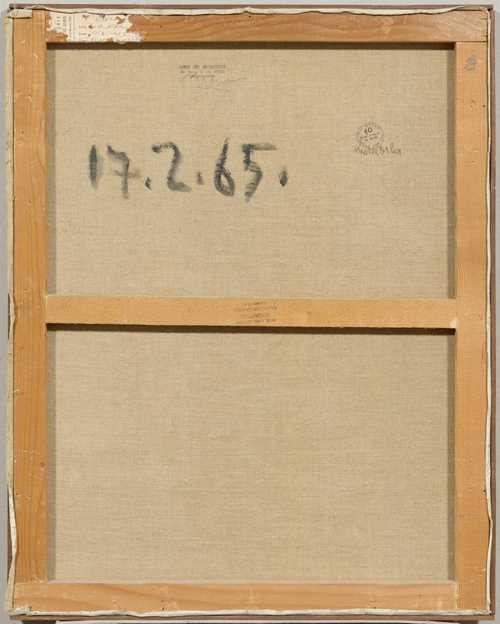
Lot 3247* - A201 Art Impressionniste & Moderne - vendredi, 01. juillet 2022, 17h00
PABLO PICASSO
(Málaga 1881–1973 Mougins)
Buste d'homme. 1965.
Oil on canvas.
Signed upper right: Picasso.
Dated on the reverse of the canvas: 17.2.65.
Dated on the reverse of the canvas: 17.2.65.
65 × 50 cm.
Certificate:
Louise Leiris, Paris, 27.6.1973.
Provenance:
- Galerie Louise Leiris, Paris, acquired directly from the artist in 1973 (label on the reverse).
- Galleria Nuovo Sagittario, Milan (stamp on the reverse).
- Private collection Italy, probably acquired from the above gallery and by descent to the present owner.
Literature:
Christian Zervos: Pablo Picasso, vol. 25, Œuvres de 1965 à 1967, Paris 1972, p. 8, no. 27 (with ill.).
In 1961, when Pablo Picasso was 80 years old, he married Jacqueline Roque and the couple moved to Mougins, in the mountains above Cannes on the Cote d'Azur. It was there, secluded from the hustle and bustle of everyday life, that Pablo Picasso produced his late work. The artist had met Jacqueline, an assistant at the Madoura pottery works, in the early 1950s and soon fell in love with her. She awakened a new wave of inspiration in him and became his last muse. Picasso produced around 400 images of Jacqueline, more than any of his previous lovers.
The late work of the Spanish painter is characterised by a flood of productivity, which began in 1963 with an intensive examination of the theme of "artist and model". Previously a portraitist of Jacqueline, he then assumed the position of the observer, the "voyeur", and depicted the way the artist transfers his model to the canvas. These images often have the same structure: seated in front of his easel towards the left of the composition and armed with a palette and brush, the painter portrays the model in the nude, who is sitting or reclining on the right.
His investigation of this theme also included a series of portraits of men. From time to time Picasso would isolate the artist from his studio and depict him facing the viewer, showing his head, shoulders and a small section of the torso. Created on 17 February 1965, "Buste d'homme" belongs to this series of paintings. While these portraits may differ in colour, size and details such as the accessories, they all share the same features. Characteristic of these paintings are the expressive, rapid brushwork, the jagged, interlocking lines of colour that adorn the sitter's face, the areas of the canvas left in reserve and employed as white fields, the stubble beard and the round, black eyes that stare back at the viewer.
In the present work, the viewer immediately notices the choice of the clothing. The blue-and-white striped Breton sailor's shirt is regarded as one of Picasso's signatures and can be seen as self-referential. Throughout his artistic career, Picasso repeatedly explored his own identity, readily adopting alter egos and portraying himself through a series of surrogate personalities, be they faun, harlequin, minotaur or musketeer, which he employed as a means of reinforcing the allegorical aspects of his work. In the present work, Picasso has not only portrayed an artist archetype, it is also a representation of the young Picasso himself. At the time he painted "Buste d'homme ", Picasso was 84 years old and increasingly coming to terms with his life and especially with his youth. He was aware that he had entered the last years of his life, a fact that gave him renewed strength and vitality. His creative process continued its compulsive development and took the form of intensive, almost obsessive production, with the painter completing two or more paintings per day.
Françoise Gilot quoted Picasso as saying: "I have less and less time, and yet more and more to say" (Gilot, 1964, p. 123 ).
CHF 2 000 000 / 3 000 000 | (€ 2 061 860 / 3 092 780)




